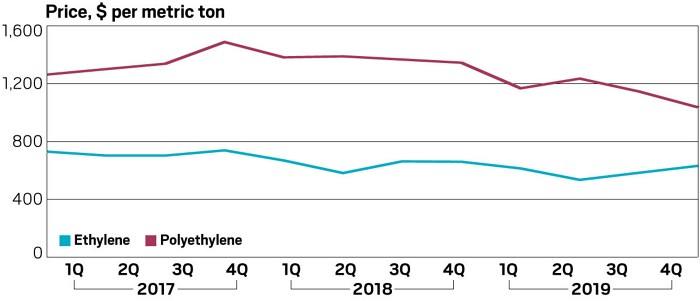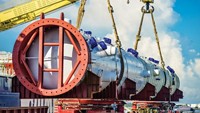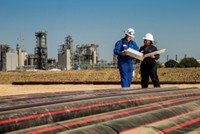Advertisement
Grab your lab coat. Let's get started
Welcome!
Welcome!
Create an account below to get 6 C&EN articles per month, receive newsletters and more - all free.
It seems this is your first time logging in online. Please enter the following information to continue.
As an ACS member you automatically get access to this site. All we need is few more details to create your reading experience.
Not you? Sign in with a different account.
Not you? Sign in with a different account.
ERROR 1
ERROR 1
ERROR 2
ERROR 2
ERROR 2
ERROR 2
ERROR 2
Password and Confirm password must match.
If you have an ACS member number, please enter it here so we can link this account to your membership. (optional)
ERROR 2
ACS values your privacy. By submitting your information, you are gaining access to C&EN and subscribing to our weekly newsletter. We use the information you provide to make your reading experience better, and we will never sell your data to third party members.
Petrochemicals
Petrochemical makers look ahead to an uncertain decade
The past 10 years have been great for US ethylene producers, but they doubt a repeat performance
by Alexander H. Tullo
March 16, 2020
| A version of this story appeared in
Volume 98, Issue 10

The US petrochemical industry’s gilded decade is drawing to a close.
Ten years ago, cheap natural gas–derived ethane started to flow to chemical makers from hydraulically fractured shale formations. Those companies, struggling against foreign competitors at the time, hoped the new source of raw material would at least help keep their plants open.
The shale-gas revolution accomplished that and much more. For the first time since the 1990s, gas-based feedstock in the US was reliably cheaper than the oil-based raw materials favored by chemical producers in Asia and Europe. Chemical exports rose, and profits swelled.
Encouraged by the money they were making, US chemical makers embarked on the largest building boom in the industry’s history. According to the American Chemistry Council, a trade group, shale gas is responsible for 340 chemical projects totaling more than $200 billion in investment since 2010.
The biggest-ticket items are the more than a dozen multibillion-dollar integrated ethylene complexes that have been rising since the beginning of the decade, mostly on the Gulf Coast. By the end of this year, these projects will add a total of about 11 million metric tons (t) per year of new ethylene capacity.
According to Steve Lewandowski, vice president of global olefins at the consulting firm IHS Markit, the US industry had 28.4 million t of ethylene capacity in 2015. The new crackers, plus smaller expansions of existing plants, will amount to a nearly 50% increase in US ethylene capacity by the end of this year.
This new production, in addition to the large cracker complexes sprouting up in China, is more than the market can absorb. Prices have been falling, and profits for chemical makers have been shrinking. Recovery, observers say, will take several years.
Sources: Company documents. Note: EG means ethylene glycol, EO means ethylene oxide, n.d. means not disclosed, PDH means propane dehydrogenation, and PE means polyethylene. a A new ethylene plant meant to back integrate existing derivative capacity. b Expansion is meant to supply a MEGlobal ethylene glycol plant.

The next decade in petrochemicals will play out differently than the last one did. Continued exploration for oil and gas in the US means the domestic industry should retain its competitiveness. Executives, however, will be cautious about paying for more big complexes. The US isn’t likely to see a half-dozen ethylene plants—which can take several years to build—going up all at once again.
Uncertainty about consumption also looms. The world economy is growing, and developing countries will require more plastic goods. But it is difficult, even for experts, to predict how much the backlash against single-use plastics will cut into that growth.
The US industry is now past the crest of its building wave. Dow, ExxonMobil, and Chevron Phillips Chemical opened enormous new plants in 2017 and 2018. Four projects—from Sasol, Shintech, Westlake Chemical and Lotte Chemical, and Formosa Plastics—started up last year. And projects at Indorama, Total and Borealis, and Dow are on tap for this year.
According to IHS’s Lewandowski, the world needs an additional 6 million t of ethylene every year. As the new capacity has outstripped this consumption, global plant operating rates are declining, from 89.3% in 2019 to 86.4% this year, he says.
Prices have been dropping in tandem. According to LyondellBasell Industries, ethylene’s US price fell from $739 per metric ton during the fourth quarter of 2017 to $632 in the fourth quarter of 2019. The price of polyethylene, the largest-volume ethylene derivative, dropped over the same period from $1,488 per metric ton to $1,036.
Nestor de Mattos, North America vice president of packaging and specialty plastics at Dow, says the market should become better balanced as construction of new plants winds down. “Margins took a steep decline last year. As we look at 2020, maybe we’ll see a marginal decline. But I would say that over the next couple of years, we expect margins to get a bit better as demand outpaces supply,” he says.
“We are definitely in a low-margin period in our cycle,” says Rocky Vermani, senior vice president of olefins and feedstocks for Nova Chemicals. Firms in Asia, where the cost of producing a metric ton of ethylene can be significantly higher than in North America, are barely treading water and even losing money. “North America is still a competitive place,” he says.
Dow’s de Mattos agrees. “Definitely Asia and Europe will be under a lot more pressure than the North American producers,” he says. In fact, he speculates that both regions could see plants close—a development that would bring better balance to the market.
Dow, for its part, shelved plans last year to build a polyethylene plant at one of its European sites. “North American producers will continue to run as hard as they can as they continue to seek market share globally,” de Mattos says.
Source: LyondellBasell Industries.

IHS’s Lewandowski expects the industry won’t climb out of the current trough until 2022. And the wild card of the new coronavirus might push the recovery out until 2023.
The outbreak of the coronavirus, known as SARS-CoV-2, has ground industrial production to a crawl in China. The biggest impact, Lewandowski says, has been on segments downstream from petrochemicals, such as clothing and shoe manufacturing. “All the labor-intensive stuff is shut down or slowed down,” he says. “Raw materials are getting backed up.”
Nova’s Vermani says chemical imports are mounting on Chinese docks as well. “What you are seeing now is inventory starting to build up because all that stuff that was on its way—it got onto the boats, but there is no demand to capture that supply,” he says. “I think it will take a little bit of time to work through that.”
Lewandowski notes, however, that the coronavirus might provide some supply relief by delaying the opening of new Chinese petrochemical projects by as long as 6 months.
Another new factor is oil prices. Coronavirus fears, plus a price war between Russia and Saudi Arabia, caused oil prices to see a more than 30% decline in a single day last week, their largest drop in nearly 30 years. Persistent lower oil prices might stimulate more demand for petrochemical products, Lewandowski says. On the other hand, they could cut into the competitive advantage US producers enjoy versus their foreign rivals.
Yet another wild card, at least in the long term, is the crackdown on single-use plastics. Around the world, governments are banning items like plastic bags and straws and mandating recycled content in packaging. Large consumer product companies are also pledging to reduce the amount of polymer they use and to mix more postconsumer resin into their packages.
Such measures might cut into demand growth, observers say, but they don’t spell doom. Single-use plastics make up about 10% of worldwide polyethylene demand, Lewandowski says. “Ten percent is still a lot, 16 million metric tons,” he says.
Plastics markets normally expand at 1.2–1.3 times overall economic growth, Vermani points out. He doubts that bans and other policies against single-use plastics will push that multiple below 0.8 or 0.9. “The use of chemicals and the use of packaging, as populations increase, as economies grow, is going to continue to grow as well. But the rate of that growth can absolutely change,” he says.
Ron Corn, senior vice president of petrochemicals at Chevron Phillips, believes much of the backlash against plastics is itself unsustainable. “It’s easy to say you’re going to ban something, but it is hard to actually live without it,” he says.
Plastics are less costly and better for the environment than alternatives like metal, glass, and paper, Corn argues. They prevent food spoilage and are cheaper to haul over long distances than other materials. “People are going to realize they need our products, and that’s why we’re bullish on demand growth,” he says.
Still, the industry likely won’t be as bullish about building new capacity as it was over the past decade. “I think it will happen at a much slower pace, with a much more diligent approach,” Dow’s de Mattos says.
One reason, he says, is that while natural gas is still less expensive than oil, the advantage is not likely to be as lopsided as it was over the past decade. He adds that many big chemical company industrial sites are packed to their fences, meaning new ethylene and derivatives projects will need to be built on wholly new sites at higher cost.
Only six projects are planned for the years after 2021, and some of those aren’t certain. Shell Chemical’s project in Pennsylvania and an ExxonMobil-Sabic joint venture in Texas are already under construction. Three—a Chevron Phillips–Qatar Petroleum joint venture on the Gulf Coast, a PTT Global Chemical America–led project in Ohio, and a massive Formosa Petrochemical project in Louisiana—are awaiting final investment decisions. Another project, Motiva Enterprises’ on the Gulf Coast, seems less likely now that the company has purchased an ethylene cracker in Texas from Flint Hills Resources.
Although construction momentum has slowed, the feedstock situation continues to be good. Back in 2011, Chevron Phillips was the first company to announce a new cracker project in a generation. Chemical executives realized that ethane was becoming plentiful, but they didn’t realize just how much so. A new cracker was a tough sell to Chevron Phillips’s board.
“I had to convince them that there was enough for at least two crackers, and we’d be one of them,” Corn says. “You had to have some degree of faith that the shale revolution would yield the results that it did.”
Since then, North American ethane resources have only increased. The Permian Basin in West Texas, intensely developed over the past few years, has yielded natural gas supplies ample enough for new US facilities and exports to boot. This is one reason, Corn says, that Chevron Phillips is developing a second project on the Gulf Coast, this time with Qatar Petroleum. “We have a continued line of sight to competitive feedstock,” he says.
In contrast, Nova Chemicals pulled out of a project with Total and Nova’s sister company, Borealis, to build a cracker and polyethylene plant in Port Arthur, Texas. Vermani says the project has “great economics” but that Nova “had to prioritize and focus on other things.”
One focus is a lawsuit Nova lost to Dow over operations the companies share in Alberta. Nova could be forced to pay $1.1 billion. “We are working through that and then still keeping our eyes on the future, still keeping our eyes on growth,” Vermani says.
And the company has its hands full with the construction of a polyethylene plant and a 50% expansion of its cracker in Ontario, which should add 450,000 t of ethylene capacity by 2022.
Vermani couldn’t be happier about the timing of that project. “By the time we come into 2022, the market should be better,” he says.





Join the conversation
Contact the reporter
Submit a Letter to the Editor for publication
Engage with us on Twitter